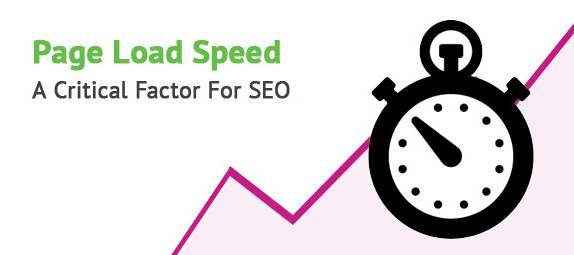It’s common not to pay much attention to website loading speed as long as it remains between more or less acceptable levels wich don’t make us waiting forever for content. However, web speed is becoming an increasingly important factor and optimization efforts in this area can be decisive for success or failure in achieving our goals.
Below are the top 5 reasons why you should start worrying about website speed and page loading times.
1. Website speed is an important SEO factor
There are many factors that search engines take into consideration when classifying the web and displaying the most relevant search results. Speed is one of them, as Google acknowledged in its 2010 official announcement.
Even today it is discussed how important the web speed factor is, but it’s clear that given the same level of relevance of search results, a typical user prefers those with less loading time. And this is perfectly known by search engines, that starting from this premise, will place closer to the first position those pages that have shorter response times, giving more weight to factors related to server side (server response time, use of CDNs, optimization of database and application, etc.) than client side («document complete» and «fully rendered» times), as it is demonstrated by this study. Furthermore, this occurs the same way as the user connects using a mobile, tablet or desktop PC.
Therefore, we can conclude that our website will never excel above others of similar relevance if they are faster.

But after all, it’s not so much of the improvement in SERPs your site will experience if you strive to make it faster, but the penalty it will suffer if Google thinks it is too slow compared to other sites that compete with the same keywords.
You don’t get a boost for having a fast site. Sites that are outliers in terms of being slow will rank lower. All other things being equal, a site that’s too slow will rank lower. – Matt Cutts
This slowness limit is relative, so we can not set a threshold from which to feel safe. It depends on the type of content and the number of resources offered by our website (number of images, videos, audios, etc.) as well as the loading times of other sites we are competing with. If they are very fast the speed factor becomes more critical.
Thus, only based on the SEO aspect we should start working on increasing our site’s speed as soon as possible. But if we still have any doubt, then see other important reasons to do it regardless of search engine optimization.
2. Faster Loading Speed = Better User Experience
Everybody is getting busier today and for all of us time is precious. So we all like to browse a website quickly to minimize wait times when getting the desired information.
For this reason, the same way we take care of other website aspects like usability and user experience it should be a priority that users enjoy our content in a quick and convenient way minimizing access times. This will result in increased visibility, lower bounce rate, more users sharing our content and greater user overall satisfaction to be associated with our brand in his mind.
3. Optimize load times leads to an increase in conversions
Related to the above, numerous studies have shown that optimizing load times is a boost in conversions , as faster websites are more accesible and users are more willing to keep browsing it. Understanding the direct impact wich website speed has on user experience is critical to marketers, as is well demonstrated that too long waiting times affect users behavior, which will jump to another browser tab or close it if they think they have waited long enough, causing lost sales and increased bounce rates, which will in turn affect SEO.
According to a study conducted in 2009 by Amazon, an extra second on page loading time means a 10% reduction in conversions. The graph below shows the results of a later study by Walmart. You see how conversion rate falls when increasing website loading times:

Waiting time that users are willing to admit tends to be diminishing. In 2006 most users expected a page was loaded in less than 4 seconds. Three years later, in 2009, 47% of users expected a page was loaded in less than 2 seconds , and in 2012 that percentage increased to 70%. That is, today you can consider it unacceptable that a page takes longer than 2 seconds to load , whether done through a desktop PC, a tablet or a smartphone, so that anyone in charge of a serious website looking to get some good results should make the effort is necessary to achieve that the limit of 2 seconds is not exceeded.
4. Speed is crucial for mobile users
As discussed earlier, no matter what device are using users today in terms of their tolerance to loading times. For this reason we must make a greater effort if possible to increase the speed of the mobile version of our site, as mobile devices typically do not benefit from such a fast connection as desktops do. Being the network latency greater we must ensure that our response times are as low as possible so that the sum of both does not exceed the threshold of 2 seconds that we have set as a goal.
Furthermore, there is another factor to consider wich is the perception of speed , ie the time that elapses until the requested page is usable (Time To Interactive Document). This time is decreased for example by loading the text and key elements needed for a page is readable first so the user can begin to get something out from it although the page has not finished loading.
5. More speed equals a better use of your own resources
Some of the key mechanisms for speeding a website consist of removing superflous elements and minimizing the number of connections made to the server when pages requested by users are loaded. This is achieved by reducing the number of images used by our website graphic design, combining them into a single file (sprites), combining all the javascript and CSS in two single files, compressing files and headers, using caching methods to avoid reloading resources that are already in the user’s browser, etc.
All these actions result in our server having to meet less requests (less use of hardware resources) and the required network bandwidth and monthly data transfer contracted with our provider being reduced. That is, they lead to a better use of available resources and therefore savings in our operating costs or an increase in our server capacity at the same price.
Also, if a website is fast search engine crawlers will also crawl faster , which in turn results in less impact our server resources and further reducing our infrastructure costs.





Comments
Submit comment